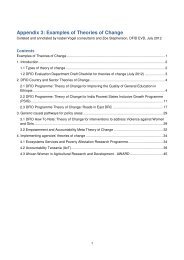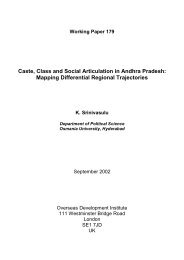Full Report - Research for Development - Department for ...
Full Report - Research for Development - Department for ...
Full Report - Research for Development - Department for ...
Create successful ePaper yourself
Turn your PDF publications into a flip-book with our unique Google optimized e-Paper software.
Background<br />
many LICs and LMCs, it is now crucial to establish evidence-based ways of<br />
improving models of service delivery and access to and uptake of maternal and<br />
infant care in order to improve maternal and child outcomes.<br />
Levels of infant mortality are often lower in urban areas than in rural at the<br />
aggregate level (UNSD, 2008). However recent trends have shown mortality<br />
improvements in the rural areas and increases in the urban areas with the<br />
exception of a few South Asian countries (UNSD, 2008). Central American and<br />
central Asian countries often show a higher level of mortality in urban areas than<br />
rural. This is possibly due to the rapid urbanisation, which often occurs without<br />
appropriate planning <strong>for</strong> infrastructure and health services. The differences<br />
become even more striking when we consider the gap between the poor and the<br />
rich. While we have a more even distribution in rural areas, the inequality within<br />
urban areas is often striking. A recent study in sub-Saharan African (SSA) countries<br />
(Anyamele, 2011) showed a considerably higher level of infant mortality in rural<br />
areas, but also a high level of variation within urban areas when considering level<br />
of wealth. However, data on maternal mortality by residence is very hard to<br />
estimate due to the small numbers. One recent study by Matthews et al. (2010)<br />
shows how the urban advantage is almost non-existent when we account <strong>for</strong> wealth<br />
levels within areas. In urban areas, they remark that this is mainly due to poverty<br />
marginalisation, which prevents access to care.<br />
Despite growing evidence of poor maternal and infant health outcomes and<br />
inequalities within urban areas of low income countries, a systematic analysis and<br />
synthesis of evidence as to effective models of service delivery is lacking. The aim<br />
of our study was to conduct a robust systematic review to address the question:<br />
What are the effects of different models of delivery <strong>for</strong> improving<br />
maternal and infant health outcomes <strong>for</strong> poor people in urban areas in low<br />
income and lower middle income countries?<br />
Through the systematic review we aim to provide important in<strong>for</strong>mation and draw<br />
out key recommendations <strong>for</strong> policy makers at international, national and subnational<br />
levels.<br />
1.2 Definitional and conceptual issues<br />
1.2.1 The urban poor: who and where? 2<br />
Urban growth – including the absolute and relative number of urban dwellers and<br />
the physical expansion of urban areas – is ‘reshaping’ population health,<br />
particularly among the urban poor (Commission on Social Determinants of Health,<br />
2008, p.4). By 2050, there will be an estimated 6.4 billion urban dwellers,<br />
compared to 3.4 billion in 2009 (UNHABITAT, 2010), and the global future has been<br />
described as a ‘planet of cities’ (Angel et al., 2011).<br />
By 2050 it is estimated that seven out of every ten people will live in a city, with<br />
almost all of this growth taking place in developing countries. It is estimated that<br />
one in three urban dwellers lives in a slum, meaning that an estimated 828 million<br />
people are currently living in in<strong>for</strong>mal settlements, producing so-called ‘hidden<br />
cities’ (UNHABITAT, 2010). More than 90 percent of slums are located in cities in<br />
developing countries, and those cities that are the fastest growing are most likely<br />
to have in<strong>for</strong>mal settlements. In sub-Saharan Africa, it is estimated that more than<br />
60 percent of city dwellers inhabit slums (UNHABITAT, 2010).<br />
2 Unless stated otherwise, all data are drawn from United Nations <strong>Department</strong> of Economic and Social<br />
Affairs (2010) and UNHABITAT (2010).<br />
What are the effects of different models of delivery <strong>for</strong> improving maternal and infant<br />
health outcomes <strong>for</strong> poor people in urban areas in low income and lower middle income<br />
countries? 5









